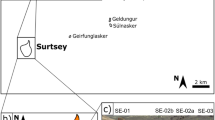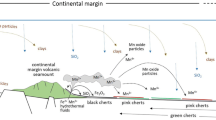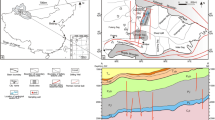Abstract
Detailed examination of igneous core recovered during Leg 37 of the DSDP, has revealed that basalt diagenesis, an alteration effect resulting from low temperature interaction with seawater, is pervasive to depths of greater than 600 meters in layer 2. Phyllosilicates are among the main components of this low grade alteration effect and occur exclusively as saponite, celadonite and interlayered mixtures of these two phases. Saponites fall into two chemical groups as (a) Mg rich-Fe poor types characteristic of oxidative diagenesis and (b) Fe rich-Mg poor types characteristic of non-oxidative diagenesis. Celadonite is entirely restricted in occurrence to the oxidative diagenetic environment (oxidation halos) and rarely, if ever, occurs as a pure phase. In this respect, X-ray and electron microprobe analyses suggest the presence of interlayered smectite in some cases and iron-oxide contamination in others.
Phyllosilicates generated during oxidative diagenesis of basalt occur in discrete mineralogical zones, typically arranged in the sequence Fe3+-oxide, celadonite, saponite proceeding outwards from a vein. The generation of these zones are modelled in terms of an infiltration dominated metasomatic process and their occurrence reflects a gradual extraction of oxygen from inflowing seawater during progressive reaction with the massive crystalline basalt.
Mass balance calculations applied to the oxidative diagenetic process suggest that a source external to the immediate environment of the massive crystalline rock is required for Si, Fe, K, Mg, Ca, and Al, in order to account for the observed secondary minerals. While Mg, K, and Ca are indigenous to seawater, Si, Fe, and Al were probably enriched in the fluid during wall rock reactions in the fracture system.
It is suggested that diagenesis of layer 2 basalts results in the extraction of Mg and K from seawater, in enough quantity to contribute significantly to the chemical mass balance of the oceans.
Similar content being viewed by others
References
Ames LL, Sand LB (1958) Factors affecting maximum hydrothermal stability in montmorillonites. Am Mineral 43:641–648
Andrews AJ (1977) Low temperature fluid alteration of oceanic layer 2 basalts, DSDP Leg 37. Can J Earth Sci 14:911–926
Andrews AJ (1978) Petrology and geochemistry of alteration in layer 2 basalts, DSDP Leg 37. Unpubl Ph D thesis, Univ of Western Ontario. London, Canada, 327 p
Andrews AJ (1979) On the effect of low temperature seawater-basalt interaction on the distribution of sulfur in oceanic crust, layer 2. Earth Planet Sci Lett 46:68–80
Aumento F, Melson WG, et al (1977) Ink Rep of the DSDP, Vol 37. Washington (US Govt Printing Office), 1008 p
Bass MN (1976) Secondary minerals in oceanic basalts with special reference to Leg 34, Deep Sea Drilling Project. In: Yeats RS, Hart SR et al (eds) Init Rep of the DSDP, Vol 34. Washington (US Govt Printing Office), p 393–432
Bischoff JL, Dickson FW (1975) Seawater-basalt interaction at 200°C and 500 bars: implications for the origin of sea-floor heavy-metel deposits and regulation of seawater chemistry. Earth Planet Sci Lett 25:385–397
Carroll D (1970) Clay minerals: A guide to their X-ray identification Geol Soc Am, Spec Pap 126:80 p
Clayton RN, Mayeda TK (1963) The use of bromine pentafluoride in the extraction of oxygen from oxides and silicates for isotopic analysis. Geochim Cosmochim Acta 27:43–52
Deer WA, Howie RA, Zussman J (1962) Rock-forming minerals. Vol 3, Sheet silicates. Longmans, London, 270 p
Drever JI (1974) The magnesium problem. In: E Goldberg (ed) The Sea, Vol 5. Wiley and Sons, NY, 337 p
Foster MD (1956) Correlation of dioctahedral potassium micas on the basis of their charge relationships. USGS Geol Surv, Bull 1036-D:57–67
Foster MD (1960) Layer charge relations in the dioctahedral and trioctahedral micas. Am Mineral 45:383–398
Foster MD (1969) Studies of celadonite and glauconite. USGS Prof Pap 614F:17p
Gray J, Cumming GL, Lambert RStJ (1977) Oxygen and strontium isotopic compositions and thorium and uranium contents of basalts from DSDP Leg 37 cores. In: Aumento F, Melson WG, et al (eds) Init Rep of the DSDP 37 Washington (US Govt Printing Office) p 607–609
Gruner JW (1944) The hydrothermal alteration of feldspars in acid solutions between 300° C and 400° C. Econ Geol 39:578–589
Hajash A Jr (1975) Hydrothermal processes along mid-ocean ridges: and experimental investigation. Contrib Mineral Petrol 53:205–226
Harder H (1970) Quartz and clay mineral formation at surface temperature. Mineral Soc Japan, Spec Pap No 1:106–108
Harder H (1972) The role of magnesium in the formation of smectite minerals. Chem Geol 10:31–39
Hart RA (1973) A model for chemical exchange in the basalt-seawater system of oceanic layer II. Can J Earth Sci 10:799–816
Hawkins DB, Roy R (1963) Experimental hydrothermal studies on rock alteration and clay mineral formation. Geochim Cosmochim Acta 27:1047–1054
Hendricks SB, Ross CS (1941) Chemical composition and genesis of glauconite and celadonite. Am Mineral 26:683–708
Hofmann A (1972) Chromatographic theory of infiltration metasomatism and its application to feldspars. Am J Sci 272:69–90
Honnorez J, Böhlke JK, Honnorez-Guerstein BM (1978) Petrographical and geochemical study of the low temperature submarine alteration of basalt from hole 396B, Leg 46. In: Dmitriev L, Heirtzler J, et al (eds) Init Rep of the DSDP 46, Washington (US Govt Printing Office), p 299–329
Humphris SE, Thompson G (1978) Hydrothermal alteration of oceanic basalts by seawater. Geochim Cosmochim Acta 42:107–125
Kastner M, Gieskes JM (1976) Interstitial water profiles and sites of diagenetic reactions, Leg 35 DSDP, Bellinghausen abyssal plain. Earth Planet Sci Lett 33:11–20
Kohyama N, Shimoda S, Sudo T (1973) Iron-rich saponite (ferrous and ferric forms). Clays Clay Miner 21:229–237
Korzhinskii DS (1970) Theory of Metasomatic Zoning. Oxford University Press
MacEwan DMC (1951) The montmorillonite minerals (montmorillonoids). In: GW Brindley (ed) X-ray Identification and Crystal Structures of Clay Minerals, p 86–137
Maynard JB (1976) The long-term buffering of the oceans. Geochim Cosmochim Acta 40:1523–1532
Muehlenbachs K (1976) Oxygen-isotope geochemistry of DSDP Leg 34 basalts. In: Yeats RS, Hart SR et al (eds) Init Rep of the DSDP 34, Washington (US Govt Printing Office), p 337–339
Muehlenbachs K (1977) Oxygen isotope geochemistry of rocks from DSDP Leg 37. Can J Earth Sci 14:771–776
Ross CS, Hendricks SB (1945) Minerals of the montmorillonite group, their origin and relation to soils and clays. USGS Prof Pap 205-B:23–79
Ryall PJC, Hall JM, Clark J, Milligan T (1977) Magnetization of oceanic crustal layer 2-results and thoughts after DSDP Leg 37. Can J Earth Sci 14:684–706
Sawhney BL (1967) Interstratification of vermiculite. Clays Clay Miner 17:347–354
Seyfried WE Jr, Shanks WC, Dibble WE Jr (1978) Clay mineral formation in DSDP Leg 34 basalt. Earth Planet Sci Lett 41:265–276
Seyfried WE Jr, Bischoff JL (1979) Low temperature basalt alteration by seawater: an experimental study at 70° C and 150° C. Geochim Cosmochim Acta 43:1937–1947
Thompson G (1973) A geochemical study of the low temperature interaction of sea water and oceanic igneous rocks. EOS Trans 54:1015–1018
Thompson GR, Hower J (1975) The mineralogy of glauconite. Clays Clay Miner 23:289–300
Tómasson J, Kristmannsdottir H (1972) High temperature alteration minerals and thermal brines, Reykjanes, Iceland. Contrib Mineral Petrol 36:123–134
Velde B (1972) Celadonite mica: solid solution and stability. Contrib Mineral Petrol 37:235–247
Williams DL, von Herzen RP (1974) Heat loss from the earth: new estimate. Geology 2:327–328
Wilshire HG (1958) Alteration of olivine and orthopyroxene in basic lavas and shallow intrusions. Am Mineral 43:120–147
Wise WS, Eugster HP (1964) Celadonite: synthesis, thermal stability and occurrences. Am Mineral 49:1031–1083
Author information
Authors and Affiliations
Rights and permissions
About this article
Cite this article
Andrews, A.J. Saponite and celadonite in layer 2 basalts, DSDP Leg 37. Contr. Mineral. and Petrol. 73, 323–340 (1980). https://doi.org/10.1007/BF00376627
Accepted:
Issue Date:
DOI: https://doi.org/10.1007/BF00376627




